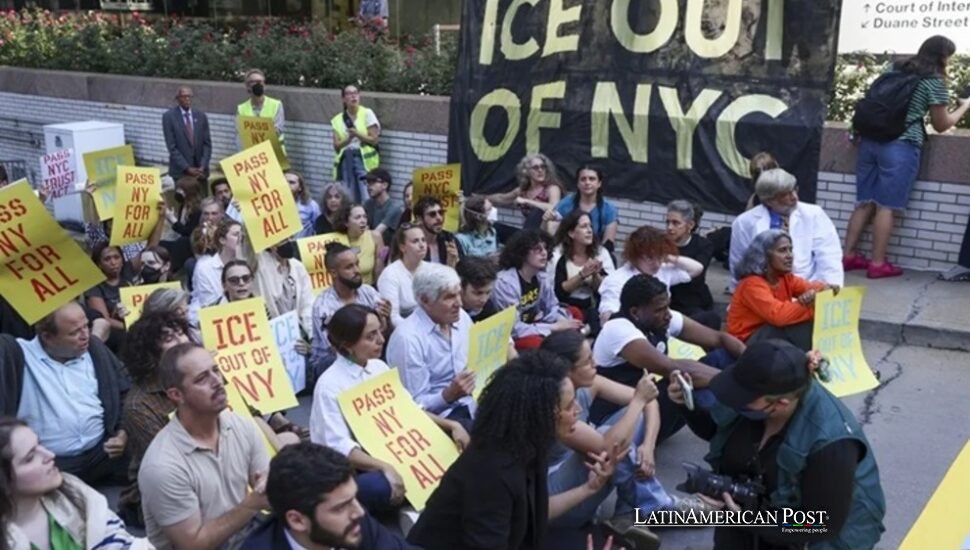At New York’s 26 Federal Plaza, Justice Collides with Latins’ Fears

A viral video of officers wrestling a mother to the ground after her husband’s immigration hearing captured more than a scuffle — it exposed a courthouse turned into a checkpoint, where justice and enforcement collide and trust splinters for Latino families across New York.
Courthouse or Checkpoint
Immigration courts are meant to be sanctuaries of due process, not ambush zones. Yet inside 26 Federal Plaza, what the BBC documented feels less like law and more like triage: a dozen officers massed in a hallway, a man pulled into custody before he can speak to counsel, a child crying in the echoing corridors.
“It’s traumatic,” said attorney Allison Cutler of the New York Legal Assistance Group, describing clients “ripped apart” before they can even grasp what is happening.
Among them was Monica Moreta Galarza, whose story has become emblematic. Moments after a judge told her husband to return for a future hearing, officers moved in. They tore her away, pinned her to the floor, and detained him. “They treated us like animals,” she told the BBC. The clip went viral within hours — a mother screaming, agents shouting — a scene as raw as it was revealing.
The Department of Homeland Security later said the officer was disciplined. But that cannot undo the real damage: families now walk into court convinced it might be their last day together. A place built to decide status has become a symbol of threat. It’s not just about one arrest; it’s about a climate. The courthouse door no longer opens to due process — it opens to fear.
Families, Cameras, and the Cost of Spectacle
When enforcement becomes spectacle, the cost is collective. The BBC witnessed not just families torn apart, but journalists thrown down. During one confrontation, officers shoved reporters to the ground; one left on a stretcher. Photojournalist Olga Fedorova said she had covered law enforcement “99 percent of the time with no issue” and had never seen anything like it.
Homeland Security defended its officers, claiming they were “swarmed by agitators and members of the press” while executing an arrest and that they had ordered people to step back. Perhaps. But public perception doesn’t parse such nuance. The footage showed the very institution meant to enforce order descending into chaos.
For the community, the message is unmistakable: entering court means entering danger. Lawyers now report clients skipping hearings out of fear. At one August session, a man with a criminal record didn’t show; the judge ordered his removal in absentia and closed his asylum claim. His absence, born of terror, sealed his fate.
Each missed appearance erodes the court’s credibility and cedes the narrative to whoever controls the hallway. If justice must be watched through a phone screen, then the state has already lost control of its story.
Due Process Versus Deterrence
The administration insists arrests at courthouses are “targeted,” focused on individuals who pose threats. Officials point to cases like Rubén Abelardo Ortiz López, whose detention preceded the takedown of Moreta Galarza, calling him a violent criminal. But the larger picture is harder to square with that defense.
According to data cited by the BBC, half of the 3,320 people detained in the New York City area since the inauguration were arrested at 26 Federal Plaza. Roughly three-quarters had no criminal convictions or charges pending.
Attorney Triciah Claxton of the Safe Passage Project said enforcement used to focus on people with serious records. Now, she warned, “the net has widened,” catching asylum seekers and parents with pending cases. What was once about public safety is sliding toward deterrence by intimidation.
The logic is chilling: make the courthouse so frightening that people choose deportation over the risk of showing up. But in that calculation, the government punishes precisely the people trying to follow the rules. It erodes the fragile bargain that keeps the system functioning — the faith that if you appear, you’ll be heard before you’re handcuffed.
The administration defends its strategy as a necessity in an age of rising border encounters and public demand for control. Yet a courthouse that operates by surprise is not security; it is theater. And theater cannot substitute for justice.
What It Means to a City — and a Country
This fight isn’t just about immigration. It’s about how a democracy behaves when it believes no one is watching. When officers tackle a mother in front of her child, when reporters are thrown down for recording a public arrest, when lawyers can’t guarantee clients five minutes of counsel before detention, the system fractures.
The government argues that those who “act like criminals will be treated like criminals,” that parents can choose deportation with their children or leave them with guardians. But the binary is brutal. Show up and risk arrest. Stay home and lose your case. In that trap, law becomes punishment by attendance.
For New York, a city built on migration, the implications are dire. A courthouse people fear to enter is not a courthouse at all. It is a checkpoint with better lighting. Even those who favor strong borders should see the danger in normalizing fear as policy. Justice requires participation; participation requires trust.
So what needs to change?
First, clear rules: courthouse arrests should be rare, targeted, and transparent. If DHS believes someone is truly a public safety threat, it can act outside the courtroom — not in its corridors. If arrests must happen there, detainees should have immediate access to lawyers.
Second, independent oversight: disciplining one officer after a viral clip is not reform. A standing public report on courthouse arrests would be.
Third, judicial protection: judges must assert authority over their courtrooms. Closing doors after chaos isn’t enough; preventing it is their duty.
Ultimately, New York’s immigration courts are now among the busiest engines of removal in the country. That might serve a national agenda, but it undermines a local one: keeping faith in the rule of law.
Also Read: Peru’s Endless Crisis: Another President Falls, and the Republic Holds Its Breath
“I feel worthless now,” Monica Moreta Galarza told the BBC, recalling the day officers threw her down beside her husband’s hearing room. No clause of the Constitution permits that feeling. If the system produces it routinely, it is not enforcing the law — it is erasing the very legitimacy the law depends on.





